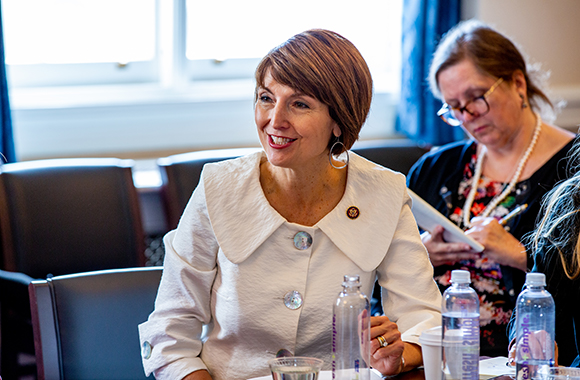by Sally Greenberg, NCL Executive Director
One of the challenges of the modern age is getting the latest and best technology out to the most remote and rural areas of the U.S. This week I was part of a panel that briefed the staffs of members in the House of Representatives on what we call “broadband deployment.” *Broadband – or “high-speed internet” is the technology that most of us city dwellers use to connect quickly to the Internet. Cable and DSL service are examples of broadband, and they give us very fast service.
Don’t we all remember the days when we were hooked into the telephone jack and could wait 30 minutes for one document to come onto the screen? That was dial-up service. Well, broadband brings that document up in seconds today. Unfortunately, the more rural parts of the country cannot get access to broadband for a number of reasons: it’s too expensive for companies to get service out to them, or in the case of many low-income citizens, they cannot afford the monthly broadband charge, which can run over $50. And equally unfortunate, it’s impossible to get businesses to set up in areas where there is no broadband available, nor do residents want to move to areas where they don’t get high-speed Internet.
For the United States, increased broadband deployment means better education, more jobs, improved healthcare, more efficient government and a better quality of life accessible for all Americans, regardless of their location or socio-economic circumstances.
Our panel, which was co-sponsored with the Alliance for Public Technology and the Communications Workers of America, featured a woman from rural Virginia who had won an essay contest in which she described how broadband had changed her life. She was a bus driver who had lost her job, and while her little town 2 ½ hours from the nation’s capital, had only had broadband access for a few years, this high-speed Internet access enabled her to take college courses and prepare for a new career.
In my presentation, I noted the NCL’s history of working on rural electrification and the parallels between getting electricity to farms in the 1930s and getting broadband access to remote areas in the new millennium. The National Consumers League is the nation’s oldest consumer organization and was part of the consumer movement that worked to bring affordable and accessible electricity to rural areas, which was one of the major consumer issues in the first half of the 20th Century. The issue had an important champion. In 1924, a New Yorker who had been a promising national official and an unsuccessful candidate for Vice President went to Warm Springs, Georgia to recover from a polio attack. Years later, in 1938, President Franklin D. Roosevelt described his experience this way to more than 40,000 people during the dedication of a rural electric cooperative in Georgia:
Fourteen years ago a Democratic Yankee came to a neighboring county in your state in search of a pool of warm water wherein he might swim his way back to health. There was only one discordant note in that first stay of mine at Warm Springs. When the first-of-the-month bill came for the electric light for my little cottage, I found that the charge was 18 cents a kilowatt-hour – about four times as much as I paid in Hyde Park, New York. That started my long study of proper public utility charges for electric current and the whole subject of getting electricity into farm homes. So it can be said that a little cottage at Warm Springs, Georgia, was the birthplace of the Rural Electrification Administration.
When Roosevelt was elected President in 1932, most of the country was frozen in the Great Depression, but the utilities and a few other industries were making unprecedented profits. A lot of this played out during the mid-1930s.
Rural electrification was a great grassroots consumer movement; rural people wanted electricity in the 1930s. Eventually with the creation of the Rural Electrification Administration in 1934 through executive order, and through the use of electric cooperatives and grassroots efforts by rural communities who sent letters to Congress supporting rural electrification, these communities demanded legislative action and asked to borrow money to build their own lines. And eventually legislation passed in 1936 to electrify rural areas. Consumer organizations were very much a part of this campaign.
Many experts agree that government should treat Internet access like it did electrical access in the 20th century. As late as the mid-1930s, nine out of 10 rural homes were without electricity. Within four years of the passage of the Rural Electrification Act, the number of rural electric systems doubled, the number of consumers connected more than tripled, and the miles of energized line was five times greater, according to the National Rural Electrical Cooperative Association.
Today the challenge of getting broadband access to urban and rural areas persists. The Pew Internet and American Life Project released a survey in July, finding that 55 percent of American adults now have broadband access at home, up from 47 percent a year earlier and 42 percent in March 2007. By contrast, only 10 percent of Americans now have dial-up access. Despite the increase in overall broadband adoption, though, growth has been flat among African-American and low-income Americans. Of the Americans with no Internet access at all, about a third say they have no interest in logging on, even at dial-up speeds. Nearly 20 percent of nonusers had access in the past but dropped it. Older and lower-income Americans are most likely to be offline.
Consumer groups are an important voice in demanding that we meet the challenge of providing Internet access to both urban areas and rural areas. Yes, there are those who say they aren’t interested in broadband, but most rural people understand they need it to succeed in the 21st Century. Broadband access has become a necessity for businesses to set up shop in rural communities, for kids to do their schoolwork, to sell homes to newcomers in communities. Today’ farmers are like us. They went to college, they’ve had broadband access for years, and they don’t and cannot do without it.
Communities of color are demanding broadband in ever greater numbers:
- African American access to the Internet has tripled over the last few years
- 66 percent of Latinos with home access to the Internet now use broadband,
President-elect Obama’s technology policy supports this trend. “America should lead the world in broadband penetration and Internet access,” he has said. His technology policy calls for providing “true broadband to every community in America.”
Broadband access is an economic engine for rural and urban areas. Connected Nation, a group promoting Internet access, says in a recent report that “just a 7 percentage point increase in broadband adoption could result in $134 billion per year in total direct economic impact” to the U.S. “Providing remote access to data gives people many more options in terms of where they work and whom they work for,” wrote Ed Felten, a computer scientist and public affairs professor at Princeton University. “Bandwidth makes people more productive,” he wrote.
What policies are we recommending? The recent enactment of the S. 1492, the Broadband Data Improvement Act, a few months ago will help greatly, but it needs to be adequately funded. There’s been no commitment to fund it by Congress so far. That bill enjoyed broad bi-partisan support. One could argue that this bill is the broadband counterpart to the 1936 Rural Electrification Act.
The Broadband Data Improvement Act creates a national grant program to help states create statewide broadband initiatives, using viability mapping, grassroots demand, extensive research, and efforts to put computers into the hands of disadvantaged communities.
This new law also requires a comparison of broadband deployment at home with broadband deployment abroad. Senator Durbin said about the bill:
“Broadband has become essential to rural areas which still lack adequate and affordable access to the Internet,” and that this “bill helps close the digital divide, ensuring that no Americans are left behind in the 21st Century’s digital economy.”
“If the United States is to remain a world leader in technology, we need a national broadband network that is second-to-none,” said Senator Daniel K. Inouye, a key champion of this bill (because he also chairs the Senate Appropriations Committee, all important when it comes to funding). “The federal government has a responsibility to ensure the continued rollout of broadband access, as well as the successful deployment of the next generation of broadband technology. But as I have said before, we cannot manage what we do not measure. This bill will give us the baseline statistics we need in order to eventually achieve the successful deployment of broadband access and services to all Americans.”
Other policy recommendations include:
- Modernize the Universal Service Fund to better reflect the realities of the digital age. Congress considered access to telephone services so vital that they created a fund to ensure universal, affordable access for low-income and rural consumers. But even though broadband has become an indispensable feature in the lives of millions of Americans, it remains out of reach for poor and rural citizens. It is time for policymakers to modernize the Universal Service Fund the program to support the deployment of broadband services.
- Require the FCC to improve its data collection on broadband markets. Policymakers cannot adequately assess the problems in the broadband market, nor identify the most appropriate solutions, if the FCC provides poor information. The starting point should be a more precise measure of which geographic area have service (using a smaller unit than the ZIP code). Beyond that, carriers should be required to report the percentages of households where broadband service is available in every service area, the percentage of households that subscribe, and the average cost per megabit of throughput. This evidentiary record will help provide an accurate analysis of the problems we face and foster solutions that will achieve results.
- Allow states to act where the federal government has failed. It is apparent that state governments cannot rely on the FCC to tell them where service is deployed in their states, much less rely on the Commission to foster competition within their states. State governments should look to the example set by ConnectKentucky and take on the task of bringing private actors and local governments together to tackle the broadband problem.
In conclusion, consumer groups are dedicated to providing greater Internet access to rural areas that don’t currently have access and to ensure that those who do have access but can’t afford the technology can get it. Broadband is necessary for so many reasons in today’s economy. The U.S. shouldn’t be 16th in broadband deployment. We should be at the top of the list.
*Links are no longer active as the original sources have removed the content, sometimes due to federal website changes or restructurings.















